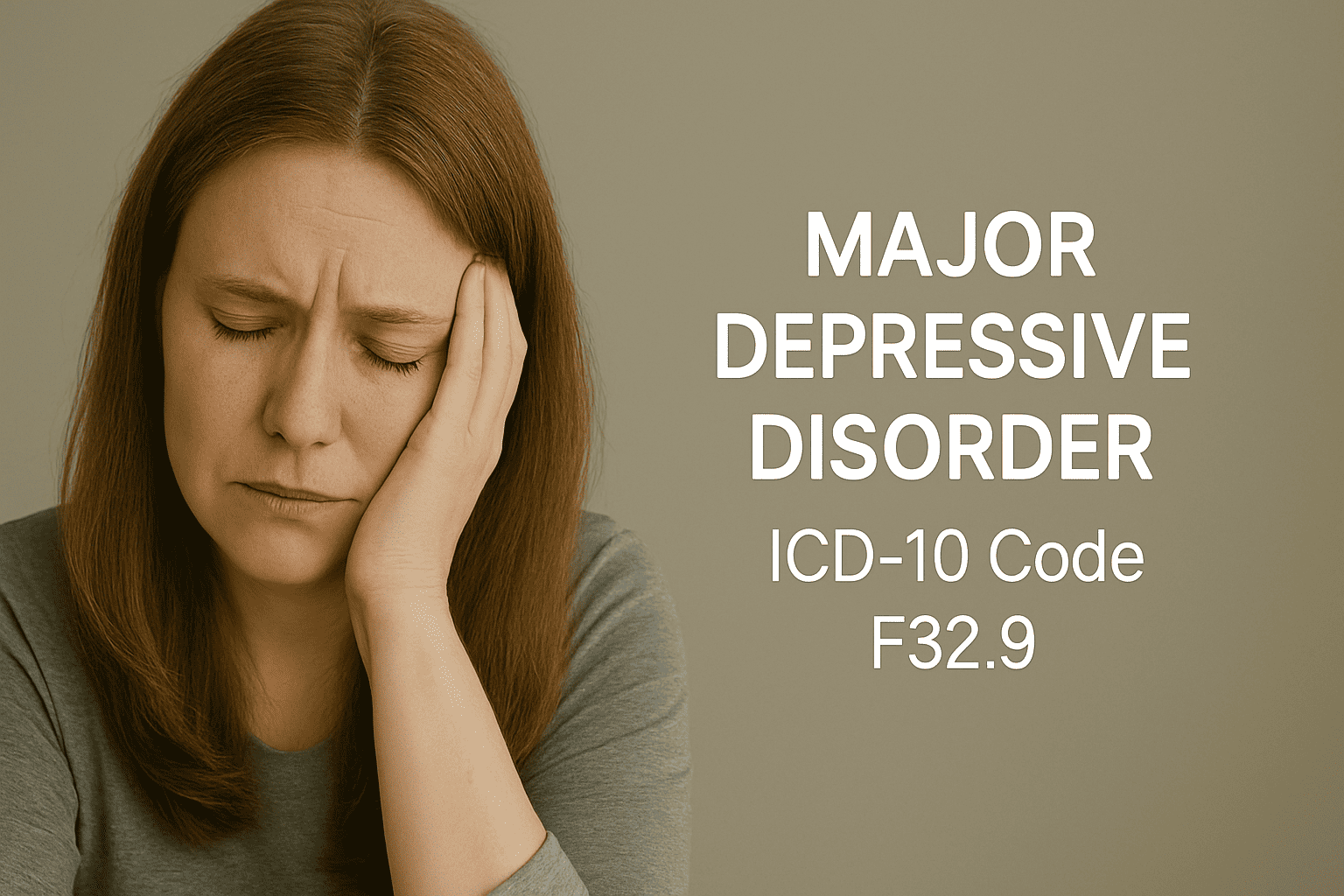Updated on: July 25, 2025
Major Depressive Disorder (MDD) is a serious mental health condition characterized by persistent low mood, loss of interest in activities, fatigue, and cognitive or physical symptoms that interfere with daily life. The ICD-10 code F32.9 is used to document a single episode of major depression without specifying severity or psychotic features.
Breakdown of ICD-10 Code F32.9
-
F32 = Major depressive disorder, single episode
-
.9 = Unspecified severity, without psychotic symptoms
Use F32.9 when:
-
A single depressive episode is diagnosed
-
The documentation does not specify if it’s mild, moderate, or severe
-
There are no psychotic symptoms mentioned
-
Depression is diagnosed but is early-stage or awaiting psychiatric evaluation
Other Specific MDD ICD-10 Codes
| ICD-10 Code | Description |
|---|---|
| F32.0 | MDD, single episode, mild |
| F32.1 | MDD, single episode, moderate |
| F32.2 | MDD, single episode, severe without psychotic features |
| F32.3 | MDD, single episode, severe with psychotic features |
| F32.9 | MDD, single episode, unspecified |
📌 Try to avoid F32.9 long-term. Once severity is clarified, update to F32.0–F32.3.
When to Use F32.9
Use F32.9 if:
-
A patient presents with depressive symptoms but severity is not clearly defined
-
Diagnosis is made in primary care, ER, or initial mental health intake
-
Patient is awaiting referral, further evaluation, or psych testing
-
The episode is single (not recurrent) and not linked to bipolar disorder
Example Documentation:
“Patient reports persistent sadness, low energy, sleep disruption, and loss of interest in activities. PHQ-9 score pending. No suicidal ideation or psychosis reported. Assessment: Major depressive disorder, single episode, unspecified (F32.9).”
Required Symptoms for MDD Diagnosis
MDD diagnosis requires ≥5 of the following symptoms, present nearly every day for ≥2 weeks:
-
Depressed mood
-
Anhedonia (loss of interest/pleasure)
-
Weight/appetite changes
-
Sleep disturbance (insomnia/hypersomnia)
-
Fatigue or loss of energy
-
Feelings of worthlessness or guilt
-
Concentration problems
-
Psychomotor changes (agitation or retardation)
-
Suicidal ideation
Diagnostic & Treatment Workflow
-
Screening: PHQ-9, GAD-7, DSM-5 criteria checklist
-
Evaluation: Determine duration, severity, functional impact
-
Treatment Plan: SSRIs/SNRIs, psychotherapy, lifestyle modifications
-
Referral: Psychiatrist or psychologist (if needed)
-
Follow-up: Medication response, side effects, mood tracking
DocScrib can track these elements and auto-populate follow-up documentation templates.
Commonly Paired ICD-10 Codes
| Condition or Supportive Diagnosis | ICD-10 Code |
|---|---|
| Generalized anxiety disorder | F41.1 |
| Sleep disturbance | G47.00 |
| Suicidal ideation | R45.851 |
| Insomnia due to depression | F51.01 |
| Adjustment disorder with depression | F43.21 |
| Long-term antidepressant use | Z79.899 |
| Counseling encounter | Z71.9 |
🧠 These support comprehensive mental health documentation and may improve claim approval.
Documentation Tips for F32.9
To justify using F32.9, ensure the record includes:
-
Clear statement of depression diagnosis
-
Duration and frequency of symptoms
-
Rule-out of bipolar or psychotic disorders
-
Absence of prior depressive episodes
-
A note that severity is not yet determined or is not documented
📋 Example: “Symptoms consistent with MDD. Awaiting PHQ-9 scoring to assess severity. Will update diagnosis as needed.”
Reimbursement & Risk Adjustment
-
F32.9 is not an HCC code, but accurate use affects:
-
Quality measures (e.g., depression screening & follow-up)
-
Psychiatric medication approvals
-
Care coordination for chronic conditions
-
-
Repeated use of F32.9 may trigger payer audits or claim denials unless supported by appropriate documentation
DocScrib’s Role in Mental Health Documentation
Mental health visits require nuanced documentation. DocScrib’s AI-powered scribe:
-
Captures PHQ-9 scores, mood observations, and clinician impressions
-
Suggests the most specific F32.x code based on encounter context
-
Supports SOAP and DAP note formats for therapy sessions
-
Helps track follow-ups, med trials, and risk assessments
👉 Explore DocScrib for mental health workflows
Frequently Asked Questions
Should I switch from F32.9 to a more specific code once PHQ-9 is available?
Yes. If severity is established, update to F32.0–F32.2 or F32.3.
Can F32.9 be used for depressive symptoms <2 weeks?
No. Use R45.2 (sadness) or F43.21 (adjustment disorder with depressed mood) until full criteria are met.
Is F32.9 appropriate for chronic low-grade depression?
No. Consider F34.1 for dysthymia or F33.x if it’s recurrent MDD.
Conclusion
ICD-10 Code F32.9 is a starting point for documenting major depression when the severity and specific features are not yet established. However, ongoing assessment and updates to a more precise F32.x code are essential for proper care delivery, risk stratification, and reimbursement. With the help of tools like DocScrib, providers can ensure depression documentation is complete, compliant, and clinically meaningful.
